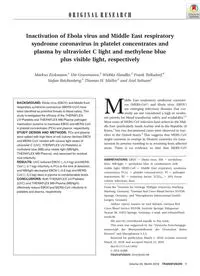
2018 Inactivation of Ebola virus and Middle East respiratory syndrome coronavirus in platelet concentrates and plasma by PDF
Preview 2018 Inactivation of Ebola virus and Middle East respiratory syndrome coronavirus in platelet concentrates and plasma by
O R I G I N A L R E S E A R C H Inactivation of Ebola virus and Middle East respiratory syndrome coronavirus in platelet concentrates and plasma by ultraviolet C light and methylene blue plus visible light, respectively Markus Eickmann,1 Ute Gravemann,2 Wiebke Handke,2 Frank Tolksdorf,3 Stefan Reichenberg,3 Thomas H. M€uller,2 and Axel Seltsam2 BACKGROUND: Ebola virus (EBOV) and Middle East respiratory syndrome coronavirus (MERS-CoV) have been identified as potential threats to blood safety. This study investigated the efficacy of the THERAFLEX UV-Platelets and THERAFLEX MB-Plasma pathogen inactivation systems to inactivate EBOV and MERS-CoV in platelet concentrates (PCs) and plasma, respectively. STUDY DESIGN AND METHODS: PCs and plasma were spiked with high titers of cell culture–derived EBOV and MERS-CoV, treated with various light doses of ultraviolet C (UVC; THERAFLEX UV-Platelets) or methylene blue (MB) plus visible light (MB/light; THERAFLEX MB-Plasma), and assessed for residual viral infectivity. RESULTS: UVC reduced EBOV (�4.5 log) and MERS- CoV (�3.7 log) infectivity in PCs to the limit of detection, and MB/light decreased EBOV (�4.6 log) and MERS- CoV (�3.3 log) titers in plasma to nondetectable levels. CONCLUSIONS: Both THERAFLEX UV-Platelets (UVC) and THERAFLEX MB-Plasma (MB/light) effectively reduce EBOV and MERS-CoV infectivity in platelets and plasma, respectively. M iddle East respiratory syndrome coronavi- rus (MERS-CoV) and Ebola virus (EBOV) are emerging infectious diseases that cur- rently are not considered a high or moder- ate priority for blood transfusion safety and availability.1,2 Most cases of MERS-CoV infection have arisen in the Mid- dle East (particularly Saudi Arabia) and in the Republic of Korea,3 but two documented cases were observed in trav- elers to the United States.4 This suggests that MERS-CoV might continue to emerge in Western countries via trans- mission by persons traveling to or returning from affected areas. There is no evidence to date that MERS-CoV ABBREVIATIONS: EBOV 5 Ebola virus; MB 5 methylene blue; MB/light 5 methylene blue in combination with visible light; MERS-CoV 5 Middle East respiratory syndrome coronavirus; PC(s) 5 platelet concentrate(s); PI 5 pathogen inactivation; RF 5 reduction factor; TCID50 5 50% tissue culture infectious dose. From the 1Institute for Virology, Philipps University Marburg, Marburg, Germany; 2German Red Cross Blood Service NSTOB, Springe, Germany; and 3Macopharma International GmbH, Langen, Germany. Address reprint requests to: Axel Seltsam, German Red Cross Blood Service NSTOB, Institute Springe, Eldagsener Strasse 38, 31832 Springe, Germany; e-mail:
